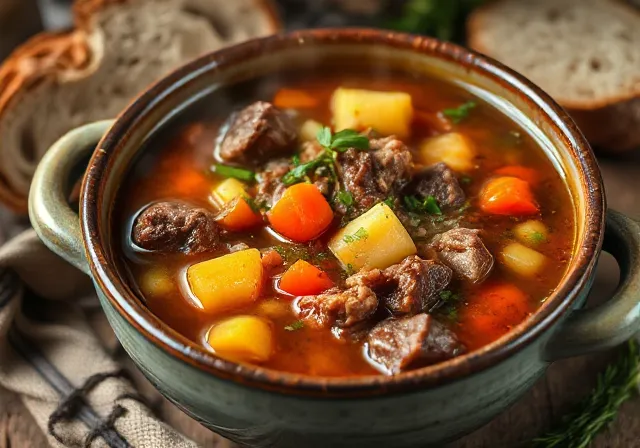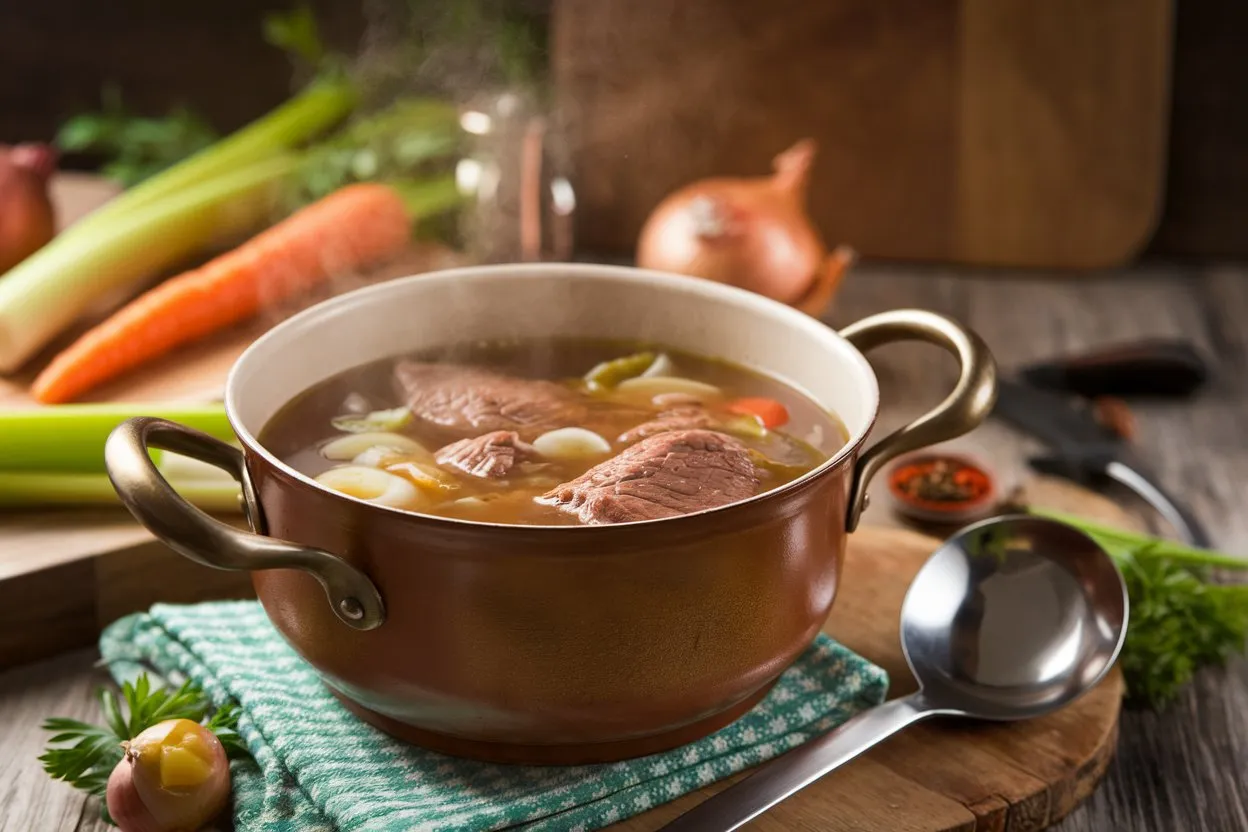Table of Contents
Introduction
Beef broth—it’s the secret ingredient that transforms everyday dishes into something extraordinary. Whether you’re looking to enhance the flavor of soups, stews, or even sauces, nothing beats the rich, homemade goodness of beef broth. But how exactly do you make it from scratch? If you’ve been relying on store-bought broth until now, this guide will show you the magic of creating your own at home. 😊
In this article, we’ll walk you through everything from choosing the right ingredients to solving common broth-making issues. Trust me, by the end, you’ll wonder why you didn’t start sooner!
What is Beef Broth?
The History of Beef Broth
Did you know beef broth dates back thousands of years? It’s a staple in cuisines worldwide, from French pot-au-feu to Vietnamese pho. The practice of simmering bones and meat to extract nutrients and flavor was a necessity in ancient kitchens, where waste was not an option. Today, it’s a culinary art that bridges history with modern cooking.
Differences Between Broth, Stock, and Bone Broth
Ever felt confused about whether to call it broth, stock, or bone broth? You’re not alone. While broth is typically made with meat and simmered for a shorter time, stock uses bones and simmers longer, resulting in a thicker consistency. Bone broth is the nutrient-packed superstar, simmered for 12-24 hours to extract collagen and minerals. Each has its place, but beef broth is the most versatile of the three.
Why Make Your Own Beef Broth?
Nutritional Benefits of Beef Broth
Homemade beef broth is a treasure trove of nutrients. Packed with protein, collagen, and essential minerals like calcium and magnesium, it’s like a natural supplement. These nutrients support joint health, improve skin elasticity, and boost overall immunity. 💪
Cost-Effectiveness Compared to Store-Bought
Making beef broth at home is surprisingly affordable. A store-bought option can set you back $4-$6 per quart, but homemade broth costs just a fraction of that, especially if you use leftover bones and vegetable scraps. Plus, no hidden additives!
Flavor Customization: Your Taste, Your Rules
One of the best perks of making your own broth? You control the flavor. Love garlic? Throw in a few extra cloves. Prefer a hint of spice? Add some chili flakes. The options are endless, and the result is uniquely yours.
Essential Ingredients for Beef Broth
Best Cuts of Beef for Broth
The foundation of great beef broth starts with the right cuts of meat and bones. Look for beef bones rich in marrow, such as shank, knuckle, or femur bones. Meaty bones, like oxtail or short ribs, also add depth to the flavor. Many butchers sell “soup bones” specifically for broth-making. If you want a richer taste, consider adding chunks of chuck roast or brisket to the mix.
Pro Tip: Roasting the bones at 400°F for 20-30 minutes before simmering enhances their flavor by caramelizing natural sugars. 😋
Vegetables and Herbs to Enhance Flavor
Classic aromatics like onions, carrots, and celery are must-haves for beef broth. They add a natural sweetness and complexity. Herbs like thyme, parsley, and bay leaves elevate the taste, while garlic provides a robust kick. You can also experiment with leeks, parsnips, or even mushrooms for a unique twist.
Spices and Seasonings for the Perfect Broth
While salt and pepper are staples, don’t overlook other seasonings. Whole peppercorns, cloves, and star anise can add subtle undertones. A splash of apple cider vinegar helps extract minerals from the bones, giving your broth a nutritional boost. Keep seasonings mild at first—you can always adjust later when using the broth in recipes.
Step-by-Step Process: How to Make Beef Broth
Prepping Your Ingredients
Preparation is key to a successful broth. Start by rinsing your bones under cold water to remove impurities. If you’re using vegetables, give them a quick wash and chop them into large chunks. No need to peel them—skins add extra nutrients and flavor!
Did You Know? Leaving the onion skin on adds a beautiful golden hue to your broth. 🌟

Cooking Methods: Stove, Slow Cooker, and Instant Pot
There’s no one-size-fits-all approach to making beef broth. Choose a cooking method based on your schedule and equipment:
- Stovetop: Traditional and time-tested, simmer your broth in a large pot for 6-8 hours. Keep the heat low and skim off foam regularly.
- Slow Cooker: Perfect for busy days! Set it on low for 8-12 hours and let it do the work while you go about your day.
- Instant Pot: Need broth fast? Use the pressure cooker setting to produce rich broth in just 2-3 hours.
Pro Tip: Never let the broth boil vigorously; it can make the broth cloudy by breaking up impurities.
Tips for Extracting Maximum Flavor
- Low and Slow: Patience is your best friend. Long, slow cooking ensures all the flavors meld beautifully.
- Skim the Foam: Remove impurities that float to the surface during the first hour of cooking. This keeps the broth clear.
- Keep it Covered: Use a lid to minimize evaporation, but leave a slight gap to let steam escape.
Common Problems and Solutions in Making Beef Broth
Why Does My Broth Taste Bland?
A bland broth often results from too little seasoning or not enough cooking time. To fix it, simmer longer to extract more flavor or add a touch of salt and herbs. For a quick flavor boost, mix in a teaspoon of tomato paste or soy sauce.
How to Avoid Cloudy Broth
Cloudiness occurs when the broth boils too hard or isn’t skimmed properly. To prevent this, always keep your broth at a gentle simmer and skim regularly. If cloudiness persists, strain the broth through a fine-mesh sieve or cheesecloth before storing.
Storage and Shelf-Life Challenges
Improper storage can lead to spoilage. Always cool your broth quickly by placing the pot in an ice bath. Store it in airtight containers in the refrigerator for up to 5 days, or freeze it for up to 3 months. To save freezer space, reduce the broth by half and freeze it as a concentrated stock. 🧊
Serving and Using Beef Broth
As a Base for Soups and Stews
Beef broth is the ultimate base for hearty soups and stews. Think classic French onion soup, robust beef barley, or comforting chicken noodle soup. The rich flavor of homemade broth elevates these dishes from good to exceptional. Simply substitute store-bought broth with your homemade version, and you’ll taste the difference instantly.
Quick Recipe Idea: Combine beef broth, shredded beef, diced tomatoes, carrots, and potatoes for a rustic beef stew that warms your soul. 🥣
Delicious Recipes Using Beef Broth
Beef broth isn’t limited to soups—it’s incredibly versatile! Use it to make:
- Risotto: Replace water or stock for a rich, savory twist.
- Gravy: Simmer broth with pan drippings and flour for the perfect roast companion.
- Pasta Sauce: Add a splash of broth to tomato-based sauces for depth.
Feeling adventurous? Incorporate beef broth into marinades, stir-fries, or even as a cooking liquid for grains like quinoa or couscous.
Alternative Non-Traditional Uses
Did you know beef broth can also shine outside the kitchen? Try sipping it as a warm, nutrient-packed drink (a favorite among athletes!) or using it as a natural remedy for colds. Its collagen content can even support glowing skin and joint health.
How to Store Beef Broth for Longevity
Proper Refrigeration Techniques
To refrigerate beef broth, ensure it cools quickly to avoid bacterial growth. Transfer the cooled broth to glass jars or BPA-free plastic containers. Keep them sealed tightly and store in the fridge for up to 5 days.
Pro Tip: A layer of solidified fat forms on the surface when refrigerated. Don’t discard it—it acts as a natural seal and can also be used in cooking for added flavor.
Freezing Beef Broth for Long-Term Use
Freezing is the best way to store beef broth for months. Use ice cube trays to freeze smaller portions, perfect for recipes needing just a splash. Once frozen, transfer the cubes to resealable freezer bags to save space.
Label the containers with the date to track freshness. Frozen broth typically stays good for 3-6 months, but for the best flavor, use it within 3 months.
Reheating Tips to Retain Flavor
When reheating beef broth, avoid boiling it, which can diminish the flavor. Instead, warm it gently over medium heat. For frozen broth, thaw it in the refrigerator overnight or place the container in warm water for faster defrosting.
Nutritional Information of Beef Broth
Calorie and Macronutrient Breakdown
Beef broth is surprisingly low in calories—just about 30-50 calories per cup—making it a guilt-free addition to meals. It contains minimal fat and carbohydrates but offers a decent protein boost.
| Nutrient | Per Cup (240ml) |
|---|---|
| Calories | 30-50 |
| Protein | 4-6g |
| Fat | 0.5-1.5g |
| Carbohydrates | <1g |
Micronutrients and Their Health Benefits
Beef broth is a source of essential minerals:
- Calcium: Strengthens bones and teeth.
- Magnesium: Supports muscle and nerve function.
- Phosphorus: Aids in energy production and bone health.
Collagen and gelatin, abundant in beef broth, promote healthy joints and skin elasticity. These compounds also support digestion by soothing the gut lining.
FAQs
Can You Make Beef Broth Without Bones?
Yes, you can! While bones add a unique richness and collagen to broth, you can create a flavorful alternative using beef cuts alone. Choose meaty portions like chuck roast or brisket, and add plenty of vegetables, herbs, and seasonings to compensate for the missing minerals and gelatin from the bones. Keep in mind that the texture will be lighter than bone-based broth but still delicious!
How Long Should Beef Broth Simmer?
The simmering time depends on your method:
- Stovetop: 6-8 hours is ideal for extracting deep flavors and nutrients.
- Slow Cooker: 8-12 hours works best, and you can let it go overnight.
- Instant Pot: Just 2-3 hours under pressure delivers a surprisingly rich broth.
Tip: For extra collagen extraction, extend the simmering time by a couple of hours without raising the heat.
Can You Reuse Beef Bones?
Absolutely! Beef bones are resilient and can be reused 1-2 times for broth. After the first batch, the flavor might be less intense, so consider adding fresh aromatics and seasonings. Remember to check for brittleness—once the bones become soft, they’ve released all their nutrients and should be discarded.
Conclusion
Making beef broth at home is more than just a cooking task—it’s a rewarding experience that connects you to traditional culinary practices while offering unmatched flavors and nutrition. From choosing the right ingredients to experimenting with creative recipes, the possibilities are endless.
Whether you’re crafting a hearty soup, whipping up a quick gravy, or sipping it as a health-boosting drink, beef broth is the unsung hero of many kitchens. With the steps and tips shared in this guide, you’re now ready to create your own broth masterpiece. 🥳
Why wait? Grab some bones, fire up the stove, and let the magic of beef broth elevate your cooking game today.

